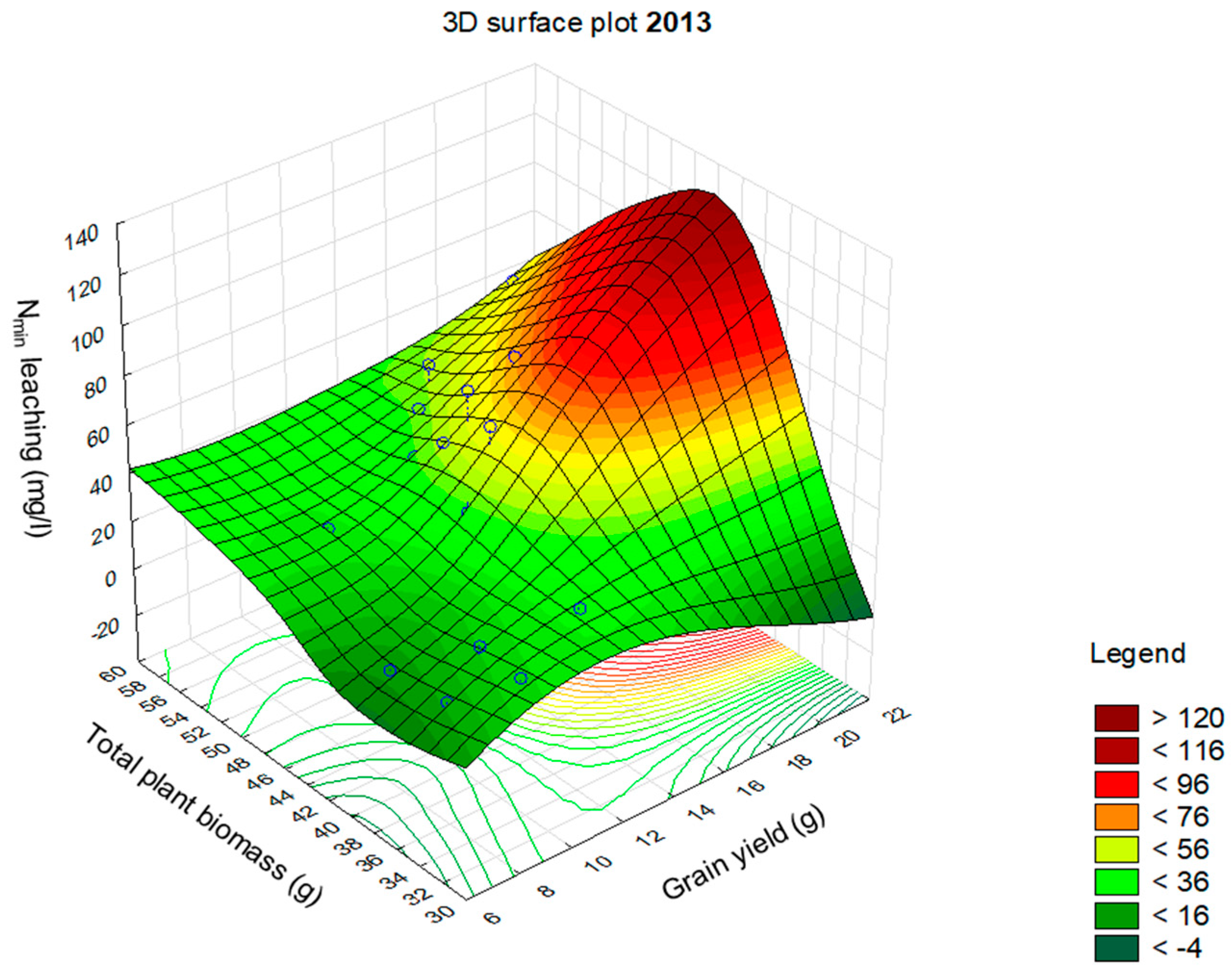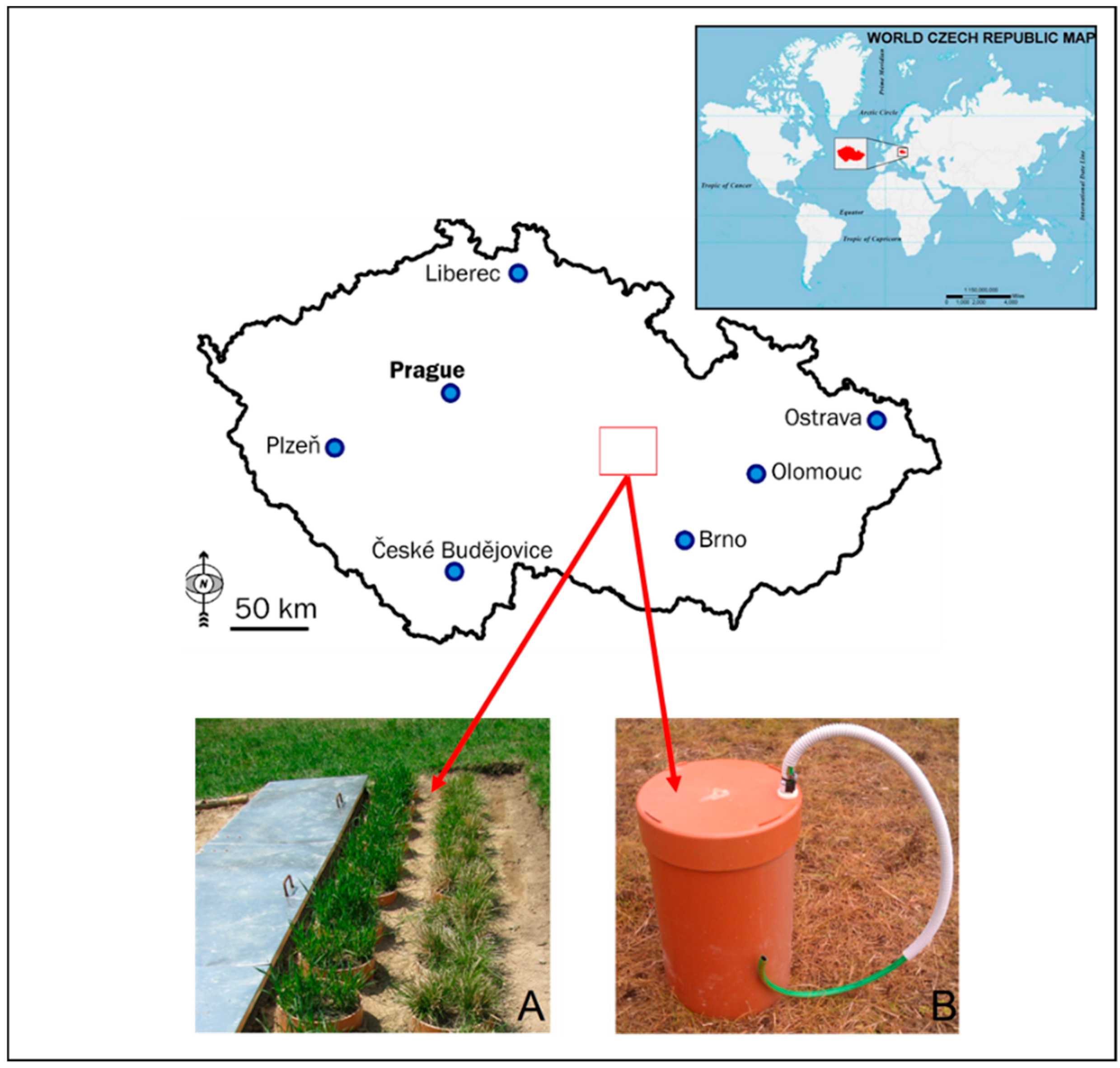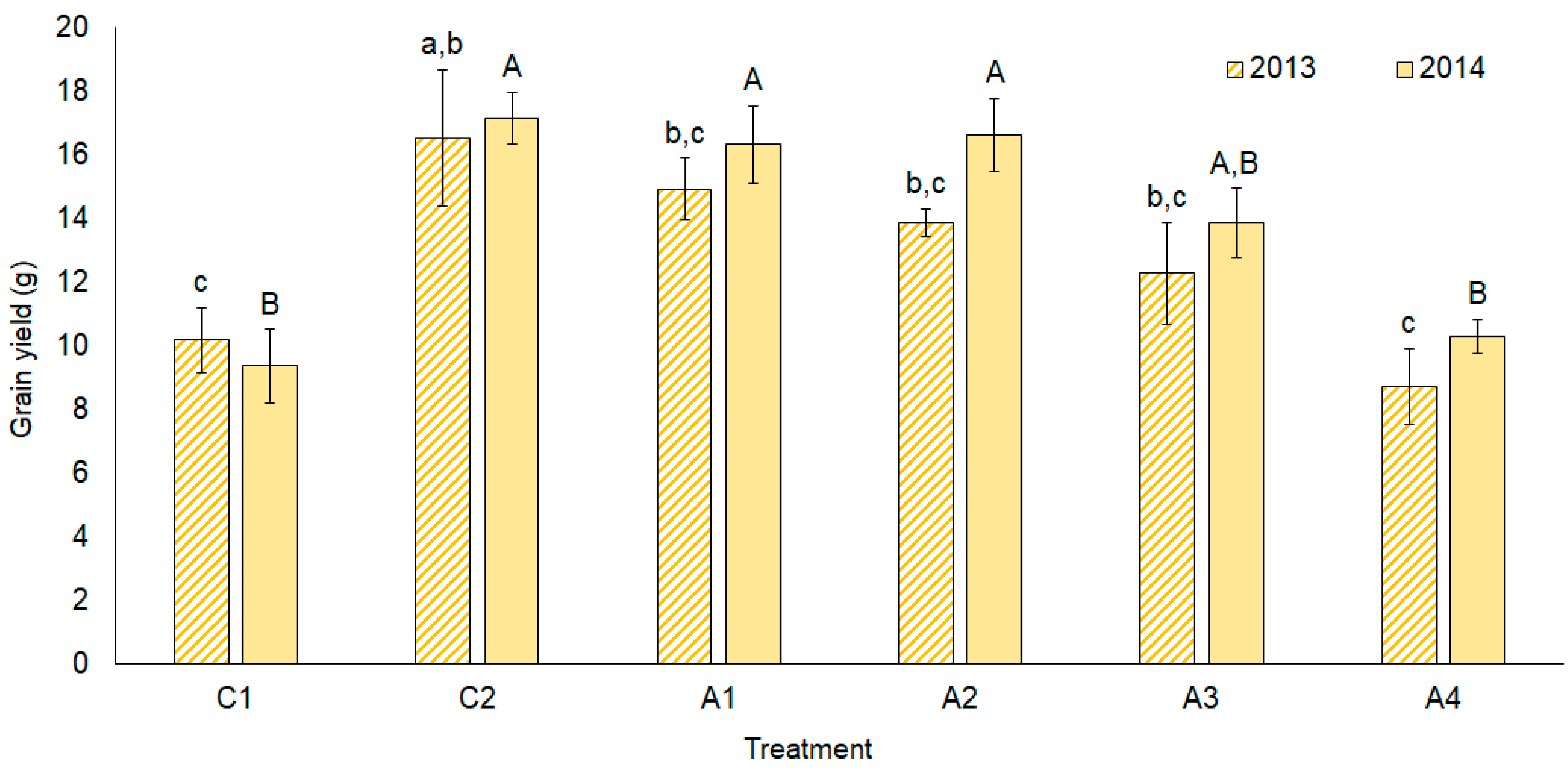Mixed Intercropping of Wheat and White Clover to Enhance the Sustainability of the Conventional Cropping System: Effects on Biomass Production and Leaching of Mineral Nitrogen
Abstract
:1. Introduction
2. Materials and Methods
2.1. Design of the Experiment
2.2. Soil Lysimeter
2.3. Leaching of Mineral Nitrogen
2.4. Analysis of Plant Biomass
2.5. Soil Properties
2.6. Data Treatment
3. Results and Discussion
3.1. Plant Biomass—Biomass Production
3.2. Grain Yield
3.3. Leaching of Mineral Nitrogen from Experimental Containers
4. Conclusions
Author Contributions
Funding
Conflicts of Interest
Appendix A

Appendix B


References
- Cassman, K.G.; Dobermann, A.; Walters, D.T. Agroecosystems, nitrogen-use efficiency, and nitrogen management. Ambio 2002, 31, 132–140. [Google Scholar] [CrossRef] [PubMed]
- Joshi, A.K.; Mishra, B.; Chatrath, R.; Ortiz Ferrara, G.; Singh, R.P. Wheat improvement in India: Present status, emerging challenges and future prospects. Euphytica 2007, 157, 431–446. [Google Scholar] [CrossRef]
- Pelzer, E.; Bazot, M.; Makowski, D.; Corre-Hellou, G.; Naudin, CH.; Rifai, M.A.; Baranger, E.; Bedoussac, L.; Biarnés, V.; Boucheny, P.; et al. Pea–wheat intercrops in low-input conditions combine high economic performances and low environmental impacts. Eur. J. Agron. 2012, 40, 39–53. [Google Scholar] [CrossRef] [Green Version]
- Canfield, D.E.; Glazer, A.N.; Falkowski, P.G. The evolution and future of Earth’s nitrogen cycle. Science 2010, 330, 192–196. [Google Scholar] [CrossRef] [PubMed] [Green Version]
- Sutton, M.A. The European Nitrogen Assessment: Sources, Effects and Policy Perspectives; Cambridge University Press: Cambridge, UK, 2011; ISBN 9781107006126. [Google Scholar]
- Bodirsky, B.L.; Popp, A.; Weindl, I.; Dietrich, J.P.; Rolinski, S.; Scheiffele, L.; Schmitz, C.; Lotze-Campen, H. N2O emissions from the global agricultural nitrogen cycle—Current state and future scenarios. Biogeosciences 2012, 9, 4169–4197. [Google Scholar] [CrossRef]
- Jensen, E.S.; Hauggaard-Nielsen, H. How can increased use of biological N2 fixation in agriculture benefit the environment? Plant Soil 2003, 252, 177–186. [Google Scholar] [CrossRef]
- Crews, T.E.; Peoples, M.B. Legume versus fertilizer sources of nitrogen: Ecological tradeoffs and human needs. Agric. Ecosyst. Environ. 2004, 102, 279–297. [Google Scholar] [CrossRef]
- Biswas, B.; Gresshoff, P.M. The Role of Symbiotic Nitrogen Fixation in Sustainable Production of Biofuels. Int. J. Mol. Sci. 2014, 15, 7380–7397. [Google Scholar] [CrossRef] [PubMed] [Green Version]
- Fields, S. Global Nitrogen: Cycling out of Control. Environ. Health Perspect. 2004, 112, A556–A563. [Google Scholar] [CrossRef] [PubMed]
- Lukina, E.V.; Freeman, K.W.; Wynn, K.J.; Thomason, W.E.; Mullen, R.W.; Stone, M.L.; Solie, J.B.; Klatt, A.R.; Johnson, G.V.; Elliott, R.L.; et al. Nitrogen fertilization optimization algorithm based on in-season estimates of yield and plant nitrogen uptake. J. Plant Nutr. 2001, 24, 885–898. [Google Scholar] [CrossRef]
- Jensen, E.S.; Peoples, M.B.; Robert, M.; Boddey, R.M.; Gresshoff, P.M.; Hauggaard-Nielsen, H.; Alves, B.J.R.; Morrison, M.J. Legumes for mitigation of climate change and the provision of feedstock for biofuels and biorefineries. A review. Agron. Sustain. Dev. 2012, 32, 329–364. [Google Scholar] [CrossRef]
- Peoples, M.B.; Herridge, D.F.; Ladha, J.K. Biological nitrogen fixation: An efficient source of nitrogen for sustainable agricultural production? Plant Soil 1995, 174, 3–28. [Google Scholar] [CrossRef]
- Olivares, J.; Bedmar, E.J.; Sanjuán, J. Biological Nitrogen Fixation in the Context of Global Change. Mol. Plant Microb. Interact. 2013, 26, 486–494. [Google Scholar] [CrossRef] [PubMed]
- Sullivan, B.J.; Smith, W.K.; Townsend, A.R.; Nasto, M.K.; Reed, S.C.; Robin, L.; Chazdon, R.L.; Cleveland, C.C. Spatially robust estimates of biological nitrogen (N) fixation imply substantial human alteration of the tropical N cycle. Proc. Natl. Acad. Sci. USA 2014, 111, 8101–8106. [Google Scholar] [CrossRef] [PubMed] [Green Version]
- Ashworth, A.J.; Taylor, A.M.; Reed, D.L.; Allen, F.L.; Keyser, P.D.; Tyler, D.D. Environmental impact assessment of regional switchgrass feedstock production comparing nitrogen input scenarios and legume-intercropping systems. J. Clean. Prod. 2015, 87, 227–234. [Google Scholar] [CrossRef]
- Anglade, J.; Billen, G.; Garnier, J. Relationships for estimating N2 fixation in legumes: Incidence for N balance of legume-based cropping systems in Europe. Ecosphere 2015, 6, 1–24. [Google Scholar] [CrossRef]
- Teng, Y.; Wang, X.; Li, L. Rhizobia and their bio-partners as novel drivers for functional remediation in contaminated soils. Front. Plant Sci. 2015, 6, 32. [Google Scholar] [CrossRef] [PubMed]
- Hauggaard-Nielsen, H.; Jensen, E.S. Facilitative root interactions in intercrops. In Root Physiology: From Gene to Function, 2nd ed.; Lambers, H., Colmer, T.D., Eds.; Plant Ecophysiology; Springer: Dordrech, The Netherlands, 2005; Volume 4, pp. 237–250. ISBN 978-1-4020-4099-3. [Google Scholar]
- Wyszkowski, M.; Radziemska, M. The effect of chromium content in soil on the concentration of some mineral elements in plants. Fresenius Environ. Bull. 2009, 18, 1039–1045. [Google Scholar]
- Muñoz-Huerta, R.F.; Guevara-Gonzalez, R.G.; Contreras-Medina, L.M.; Torres-Pacheco, I.; Prado-Olivarez, J.; Ocampo-Velazquez, R.V. Review of Methods for Sensing the Nitrogen Status in Plants: Advantages, Disadvantages and Recent Advances. Sensors 2013, 13, 10823–10843. [Google Scholar] [CrossRef] [PubMed]
- Uzoma, K.C.; Inoue, M.; Andry, H.; Fujimaki, H. Effect of cow manure biochar on maize productivity under sandy soil condition. Soil Use Manag. 2011, 27, 205–212. [Google Scholar] [CrossRef]
- Zbíral, J.; Němec, P. Comparison of Mehlich 2, Mehlich 3, CAL, Egner, Olsen, and 0.01 M CaCl2 extractants for determination of phosphorus in soils. Commun. Soil Sci. Plant Anal. 2002, 33, 3405–3417. [Google Scholar] [CrossRef]
- Nelson, D.W.; Sommers, L.E. Total carbon, organic carbon, and organic matter. In Methods of Soil Analysis. Part 3, Chemical Methods, 2nd ed.; Sparks, D.L., Ed.; Soil Science Society of America, American Society of Agronomy: Madison, WI, USA, 1996; Volume 5, pp. 961–1010. ISBN 0891188258. [Google Scholar]
- Bremner, J.M. Nitrogen Total. In Methods of Soil Analysis. Part 3, Chemical Methods, 2nd ed.; Sparks, D.L., Ed.; Soil Science Society of America, American Society of Agronomy: Madison, WI, USA, 1996; Volume 5, pp. 1085–1122. ISBN 0891188258. [Google Scholar]
- Hauggaard-Nielsen, H.; Ambus, P.; Jensen, E.S. The comparison of nitrogen use and leaching in sole cropped versus intercropped pea and barley. Nutr. Cycl. Agroecosyst. 2003, 65, 289–300. [Google Scholar] [CrossRef]
- Fustec, J.; Lesuffleur, F.; Mahieu, S. Nitrogen rhizodeposition of legumes. A review. Agron. Sustain. Dev. 2010, 30, 57–66. [Google Scholar] [CrossRef]
- Ehrman, J.; Ritz, K. Plant: Soil interactions in temperate multi-cropping production systems. Plant Soil 2014, 376, 1–29. [Google Scholar] [CrossRef]
- Haynes, R. Mineral Nitrogen in the Plant-Soil System; Academic Press: Cambridge, MA, USA, 2012; ISBN 978-0-12-334910-1. [Google Scholar]
- Tosti, G.; Farneselli, M.; Benincasa, P.; Guiducci, M. Nitrogen Fertilization Strategies for Organic Wheat Production: Crop Yield and Nitrate Leaching. Agron. J. 2016, 108, 770–781. [Google Scholar] [CrossRef]
- Fujita, K.; Godfred, O.K.; Ogata, S. Biological nitrogen fixation in mixed legume- cereal cropping systems. Plant Soil 1992, 141, 155–175. [Google Scholar] [CrossRef]
- Pirhofer-Walzl, K.; Rasmussen, J.J.; Høgh-Jensen, H. Nitrogen transfer from forage legumes to nine neighbouring plants in a multi species grassland. Plant Soil 2012, 350, 71–84. [Google Scholar] [CrossRef]
- Di, H.J.; Cameron, K.C. Nitrate leaching and pasture production from different nitrogen sources on a shallow stoney soil under flood-irrigated dairy pasture. Aust. J. Soil Res. 2002, 40, 317–334. [Google Scholar] [CrossRef]
- Zarea, M.J.; Ghalavand, A.; Goltapeh, E.M. Effects of mixed cropping, earthworms (Pheretima sp.), and arbuscular mycorrhizal fungi (Glomus mosseae) on plant yield, mycorrhizal colonization rate, soil microbial biomass, and nitrogenase activity of free-living rhizosphere bacteria. Pedobiologia 2009, 52, 223–235. [Google Scholar] [CrossRef]






| Treatment | Description | Total N Applied (kg N/ha) | Humic and Fulvic Acids (L/ha) | Fertilizers |
|---|---|---|---|---|
| C1 | Sole Crop (Control) | 0 | 0 | - |
| C2 | Sole Crop | 140 | 0 | DAM 390 |
| A1 | Mixed Cropping | 112 | 0 | DAM 390 |
| A2 | Mixed Cropping | 112 | 1.25 | DAM 390 + LG B |
| A3 | Mixed Cropping | 70 | 0.65 | DAM 390 + LG B |
| A4 | Mixed Cropping (Control) | 0 | 0 | - |
| Sample | Ctot (g/kg) | Ntot (g/kg) | C/N | Plant Available Nutrient (mg/kg) | pH (CaCl2) | |||
|---|---|---|---|---|---|---|---|---|
| P | K | Ca | Mg | |||||
| Topsoil | 13.32 | 1.41 | 9.44 | 233 | 349 | 1801 | 69 | 5.7 |
| Subsoil | 0.597 | 0.052 | 11.48 | 143 | 56 | 1451 | 46 | 6.1 |
© 2018 by the authors. Licensee MDPI, Basel, Switzerland. This article is an open access article distributed under the terms and conditions of the Creative Commons Attribution (CC BY) license (http://creativecommons.org/licenses/by/4.0/).
Share and Cite
Kintl, A.; Elbl, J.; Lošák, T.; Vaverková, M.D.; Nedělník, J. Mixed Intercropping of Wheat and White Clover to Enhance the Sustainability of the Conventional Cropping System: Effects on Biomass Production and Leaching of Mineral Nitrogen. Sustainability 2018, 10, 3367. https://doi.org/10.3390/su10103367
Kintl A, Elbl J, Lošák T, Vaverková MD, Nedělník J. Mixed Intercropping of Wheat and White Clover to Enhance the Sustainability of the Conventional Cropping System: Effects on Biomass Production and Leaching of Mineral Nitrogen. Sustainability. 2018; 10(10):3367. https://doi.org/10.3390/su10103367
Chicago/Turabian StyleKintl, Antonín, Jakub Elbl, Tomáš Lošák, Magdalena Daria Vaverková, and Jan Nedělník. 2018. "Mixed Intercropping of Wheat and White Clover to Enhance the Sustainability of the Conventional Cropping System: Effects on Biomass Production and Leaching of Mineral Nitrogen" Sustainability 10, no. 10: 3367. https://doi.org/10.3390/su10103367






